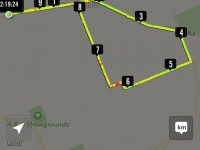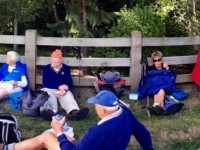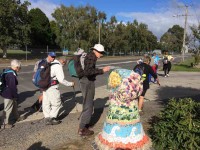1. 30/3/2016 North Taieri Road Walk. E. Leaders: Les and Margaret.



Taieri Recreational Tramping Club
Mid-week recreational and social walking group based in Mosgiel NZ
1. 30/3/2016 North Taieri Road Walk. E. Leaders: Les and Margaret.



NORTH TAIERI (WAIRONGOA) SALINE -CHALYBEATE SPRINGS.
A NEW DUNEDIN ATTRACTION.
By Murray Aston,
My rambles one day last week took me to a most delightful neighbourhood, and included a visit to the Wairongoa medicinal springs, a short account of which from my pen may be acceptable to readers of the Witness.
Some six months ago Mr Alexander Thomson, the well-known aerated water manufacturer of Dunedin, acquired by purchase 160 acres of land, taking the precaution to include the whole of the watershed so as to render any danger of contamination to the wells by undesirable neighbours an impossibility. The property is near the North Taieri township, and in the vicinity of Salisbury, the seat of Mr Donald Reid. It is distant some three and a-half miles from Wingatui or Mosgiel; but there is a flag station only a few minutes’ walk from it on the Central Otago railway. The wells are located in a gully of most romantic and picturesque loveliness. The waving toi-tois, the soft-hued ti-tri, the fern, now all changing in different shades of delightful colour, combined with tho blue distance of the mountain ranges, enchant and sooth the mind. Lizards of different species and colour darted across the path; small flocks of goldfinches, remarkable for the brilliancy of their plumage and erratic flight, momentarily arrested the attention, and huge butterflies lazily sunning themselves in their gorgeous attire lent an additional charm to the situation. A particularly clear and beautiful stream which runs through the property must not be forgotten, and trout are not an altogether unknown quantity therein. A few years ago the busy gold miner, I heard, was making good money on this same little creek, but his operations entailed serious inconvenience to the owners of the land, so he was stopped.
I found a large building for bottling waters nearly completed, with dwelling house, stabling, &c, and a fine new steam engine and boiler already on the premises. The principal (sic) well has been enclosed in a handsome red brick tower with white facings, on concrete base, the architecture being of the Tudor period with a particularly attractive castellated roof. Each spring, of which there are several, has been followed to its source in the bed-rock, which is white conglomerate of pure, crystalline formation, then concreted to the surface and bricked over. One well however has been left open for the use of visitors, of whom 30 or 40 at a time, many of them bicyclists are frequently gathered together, the proprietor relying on the well-known good sense of the public not to abuse the privilege by any unthinking act of larrikinism. The various springs contain different qualities and degrees of strength, but the water in each may, experts say, be described in scientific language as saline chalybeate. The early settlers, 30 years ago, were not slow in discovering the medicinal properties of the springs, and anaemic persons, dyspeptics, children with worms, rheumatics and people over-worked or suffering from the evil effects of dissipation are said to have derived great benefit from the Wairongoa waters. While I was at the place a man with a sack on his back approached me, and in the course of conversation stated that he had just walked out from Dunedin, 10 miles distant, for a supply of water. His sack held three large stone bottles, and having filled them it was his intention to walk back. He had been a dyspeptic, he said, and the doctors could do nothing for him; but a friend had advised him to try these waters and in one week he had derived benefit, and now, in three weeks, he was walking 20 miles in a day for the precious liquid.
It is the opinion of experts that the water travels a great distance— viz., from the Maungatoka mountain—the “Boulders Hill” of the settlers; and that it comes under enormous pressure is evidenced by the large volume of carbonic acid gas it contains which it is the intention of the proprietor to collect as it rises to the surface of the wells, store in gasometers, and utilise the supply for re-aerating the water; and a noteworthy factor in connection with the supply is that it never varies in quantity either in the driest or wettest season; and it is believed to be inexhaustible. Mr Thomson thinks that in a month from the present time he will be able to deliver supplies to those in need of it. He expects to do a large trade with the public through druggists and will supply them in syphons as well as in the ordinary bottles. The price, moreover, will be sufficiently low to bring the water within reach of persons of moderate means.
I need hardly add that I partook of water from the various springs, and I experienced great pleasure therefrom, as the effect was distinctly exhilarating to the system, and for hours afterwards I experienced a most agreeable flavour on my palate. I venture, therefore, to predict a brilliant future for the North Taieri district. Ere long a big hotel on the spot will become a necessity, and Dunedin should prove an attractive centre for tourists from all parts by reason of what I firmly believe to be its invaluable springs at Wairongoa.
– Extracted from Papers Past, Otago Daily Times, 6 April 1895, page 7.
Mr A C B Thomson lifted a moss-covered piece of wood from the track and exposed an iron pipe from which water poured into a small tank set in the ground. I gasped slightly as I swallowed the first mouthful. ‘It’s fizzy and tastes like the Tonic you have with gin.’ The water contains carbon dioxide, 99.5 per cent pure, soda, iron and many trace elements. ‘This could be a spa like those in the Black Forest but it’s much more beautiful here, I think. … There are ten natural springs in 100 yards along the track through the glade where the most surprising mixture of native and exotic trees grow together. …
… The bottling shed, where the track opens out, was built in 1894, and about six year ago was refaced with corrugated iron. Inside is a balcony with a wooden slatted front. ‘As children we used to act plays up there and the audience would sit downstairs.’ A small six-sided shed, next to this building, once housed the gasometer where the natural carbon dioxide, collected from the spring water, was used to charge the soda syphons.
Wairongoa, which means Medicine Water, was known to the Maoris and this area was first acquired by Mr John Bell who settled at Woodside. Mr Alexander Thomson purchased it from him in 1894. Bottling of the water commenced the same year in the existing shed and it was exported as far as Australia until transport and freight charges made it uneconomical. The bottling business closed down in 1939.
In this corner of North Taieri, once bare tussock, scrub, gorse and rocks, Alexander Thomson ran his farm, specialising in Clydesdales which won many prizes and championships; and he also created a beauty spot. Visitors in their thousands used to come to see the trees, spacious lawns and two splendid fountains. Trains made a special stop here. And although the bottled water was on sale in the shops, visitors were allowed to drink it on the property and to take away as much as they could carry with them. But this generosity was repaid with the most violent form of vandalism and the Thomson family were forced to close their property to the public.
Wairongoa is still closed to the public and readers are requested not to try and gain admittance. – “Taieri Buildings”, by Daphne Lemon, 1970.